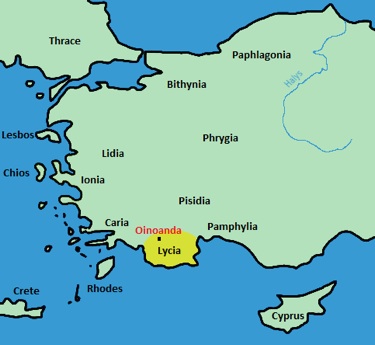
Attalus III left his kingdom in 133 BC in inheritance to Roman Empire, to which belonged Oinoanda and Lycia until they became part of the Byzantine Empire.
Oinoanda is located at the north of Lycia, at 1,400 meters above sea level, strategically placed at the top of a hill, where it could be safer from external attacks and where it dominated a plain devoted to crops.
It seems that between 100 and 200 AD it had reached 10,000 inhabitants. Of course, not all lived in the city of Oinoanda, but in its neighbourhoods. The city had a political administrative, cultural and economical role, but strictly speaking, never had so great number of inhabitants.
Although in the Diogenes’ era the city belonged to Roman Empire, the city was totally Greek. Greek was the language spoken there and Greek are all the recorded inscriptions —philosophical or not— that have been found.
We know very little of Diogenes. He was probably born in the second half of the first century, was rich and politically influential, though as a good Epicurean, he never became involved in politics.
It seems that he received his philosophical training at Rhodes, where he studied rhetoric. He has Epicurean friends not only in Rhodes, where he retired every winter to escape from the cold weather of Oinoanda, but also in Chalcis, Athens and Thebes, places where he travelled.
As he explains in the introduction of the inscription, when he was old and ill he felt that it would not live much longer, decided to give their fellow citizens —and by extension to the entire world—, a portico where he recorded the mainly tenets of the philosophy that remedies the human diseases: the Epicureanism.
The portico was built around the 120 AD, and if the earthquake in the year 140-141 did not demolish it, the inscription was probably visible for about 125-150 years.
Later, the portico was dismantled and the stones used for other purposes; to build the outer wall, to build homes, as a basis for statues, etc. Even some fragments of the Epicurean inscription have been found in a village near to Oinoanda.
Probably the city was abandoned when the aqueduct that supplied water became unusable. Experts suggest that this was in the ninth century, but there is no conclusive evidence of it. In any case, for centuries the inscription remained forgotten.
So it remained until 1884, when two Frenchmen, Holleaux and Paris arrived at Oinoanda and found some fragments of the inscription. Immediately they realized the importance of the discovery, and some years later, in 1895, Austrians Kalinka and Hereby continued the research.
The work was abandoned in the early twentieth century, and it was not until 1962 after the visit of the British Chilton, that the works were resumed. From 1968 to 1973, Martin Ferguson Smith discovered new fragments and British research teams continued working until 1983.
It should be noted that to date, the Turkish authorities have not given permission to excavate, except for a few days of 1997, when Martin Ferguson Smith, with a very precarious media, discovered new buried fragments.
Fortunately, since 2007, a team from the German Archaeological Institute works one month each summer with modern means of geophysical surveys to discover fragments buried, and records the coordinates of each fragment with GPS to find them again easily. Hopefully, the Turkish authorities will give soon permission to excavate. You can view the status of investigations here and an informational video clicking here (in German).
Despite working only on surface, today have been recovered about 250 fragments that bring about 6,000 words. However, this constitutes only a tiny part of the inscription, which is supposed to be no less than 25,000 words.
Although it is not possible to confirm until the excavation work will be performed, it is likely that the inscription of Diogenes to be placed on the so called esplanade or upper agora of Oinoanda, that at the time when the inscription was carved was the centre of the city.
According to experts' calculations, the wall where Diogenes recorded the inscription must have been about eighty metres long and four high. Probably the first fifty centimetres were not carved to avoid the readers go to knees to read it.
The inscription was ordered in a manner that each of its contents could be read as was current in those days, when they rolled out to read books.
Diogenes divided the inscription into the following sections:
- An epitome of Epicurean physics.
- An epitome of Epicurean ethics.
- Letter to Antipater.
- Letter to Dionysius.
- Instructions to family and friends.
- Maxims of Epicurus.
- Writings of Epicurus.
- Treatise on old age.
Except the treatise on old age, which is itself a work of Diogenes, on the other sections the inscription offers a canonical exposition of Epicureanism, with slight variations of what Epicurus had said 400 years before.
Most of the fragments have been translated by Martin Ferguson Smith, probably the greatest expert in the inscription, which was also responsible for drawing them. Indeed, his work is indispensable for understanding Diogenes’ work.
As unfortunately time —and especially the enemies of Epicureanism— have made the work of Epicurus lost almost entirely —only remain three letters of Epicurus, his Basic Doctrines, his Vatican Sayings and scanty and dispersed —, the inscription of Diogenes can bring new light to our knowledge of Epicureanism in the future, especially if it is possible to recover more fragments that still remain buried today.
Finally, you can watch a lecture on Diogenes of Oinoanda here (in Catalan).

